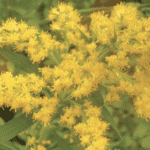By Deborah J. Benoit, UVM Extension master gardener
When someone mentions wildflowers, what comes to mind? Daisies? Black-eyed Susans?
They’re as familiar as the summer days of our youth, so well-loved that we often pick wildflowers for bouquets or add them to our gardens. What we call weeds tend to be any plant claiming a place for itself at our homes uninvited and unwelcome.
Goldenrod (Solidago) blooms in late summer and early fall. Allergy sufferers curse the yellow-plumed wildflower as a truly obnoxious weed. The truth is goldenrod doesn’t cause all the sniffling and sneezing (its pollen isn’t windborne as it is too heavy).

If allowed to spread unchecked, goldenrod can be a nuisance although many gardeners welcome this perennial as its flowers are a favorite of bees, butterflies and other pollinators.
The real culprit is ragweed (Ambrosia artemisiifolia), a weed you probably never noticed that blooms at the same time as goldenrod. Its pollen is plentiful and spreads easily on the breeze.
While goldenrod can be a bully in the garden if allowed to spread unchecked, this perennial’s flowers are a favorite of bees, butterflies and hummingbirds. It’s a native wildflower that grows between 3-5 feet tall, so it’s hard to miss.
Queen Anne’s lace (Daucus carota) with its lacey foliage and flat, umbrella-like clusters of white flowers is a familiar sight along roadsides. Unlike goldenrod, it is a naturalized non-native with origins in Europe and Asia. It grows 3-4 feet tall and flowers from June through August. While it makes a lovely addition to cut flower arrangements, some people may be sensitive to its sap.
If you’re out picking wildflowers, beware of lookalikes. American cow parsnip (Heracleum maximum) is native to North America. While its flowers are similar to those of Queen Anne’s lace, its foliage is quite different and the plant is much larger, growing up to 8 feet high. Its sap is phototoxic, meaning that if it gets on your skin and is exposed to sunlight, blisters can result.
Wild parsnip (Pastinaca sativa) looks like Queen Anne’s lace, too, but its flowers are yellow. It is highly invasive. Remove the plant or flowerheads before blooming to avoid spreading by seed. Be sure to cover exposed skin to avoid contact with the sap as it’s also phototoxic.
Giant hogweed (Heracleum mantegazzianum) is an even more dangerous lookalike. It is invasive in Vermont and a federal recognized noxious weed. Giant hogweed can reach heights of 7-20 feet. Touching it causes exposure to its phototoxic sap and can result in severe skin reactions or chemical burns.
Jewelweed is a native wildflower you’ve probably seen even if you don’t know its name. Spotted jewelweed (Impatiens capensis), also known as orange jewelweed or spotted touch-me-not, and pale jewelweed (Impatiens pallida), also known as yellow jewelweed, are annuals native to eastern North America.
Jewelweed grows 2-5 feet tall and blooms from mid-summer through frost. Its dangling flowers are attractive to hummingbirds and bees. Jewelweed spreads by seeds that “explode” out of the pod when touched and easily self-seed. If you find yourself with an overabundance of jewelweed, it’s easy to pull by hand due to its shallow roots.
While native jewelweed is a beautiful and beneficial wildflower, its lookalike relative, Himalayan balsam (Impatiens glandulifera), is an import from Asia. It’s on the watch list as a potential invasive plant in Vermont. Although its appearance is similar to its native counterparts, Himalayan balsam is easy to identify when in bloom. Its flowers are pink or purple in color.
So, the next time you’re out for a drive in a rural setting, take a look at what’s growing along the roadside. Are they wildflowers? Or are they weeds?
More information on invasive plants (and the dangers they present) can be found at: vtinvasives.org.




